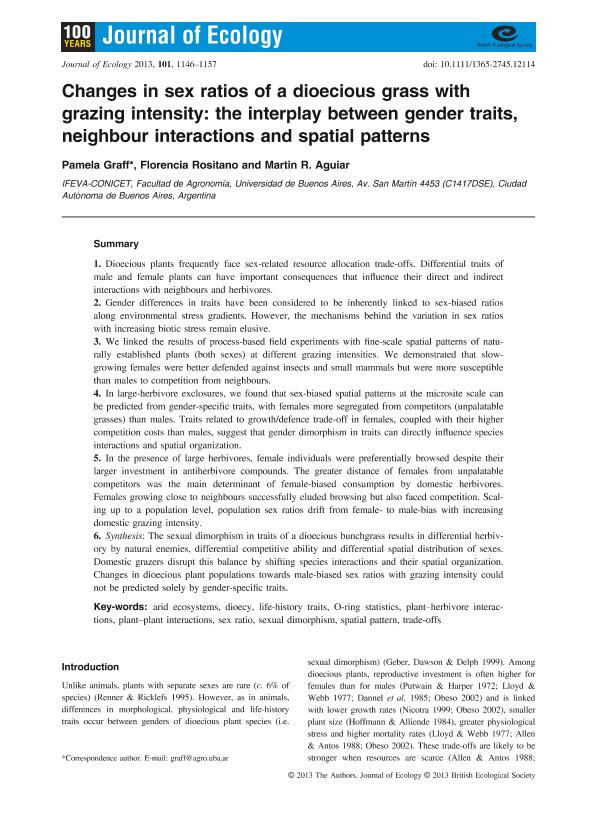Artículo
Changes in sex-ratios of a dioecious grass with grazing intensity: the interplay between gender traits, neighbour interactions and spatial patterns
Fecha de publicación:
09/2013
Editorial:
Wiley
Revista:
Journal of Ecology
ISSN:
0022-0477
Idioma:
Inglés
Tipo de recurso:
Artículo publicado
Clasificación temática:
Resumen
1. Dioecious plants frequently face sex-related resource allocation trade-offs. Differential traits of male and female plants can have important consequences that influence their direct and indirect interactions with neighbours and herbivores. 2. Gender differences in traits have been considered to be inherently linked to sex-biased ratios along environmental stress gradients. However, the mechanisms behind the variation in sex ratios with increasing biotic stress remain elusive. 3. We linked the results of process-based field experiments with fine-scale spatial patterns of naturally established plants (both sexes) at different grazing intensities. We demonstrated that slowgrowing females were better defended against insects and small mammals but were more susceptible than males to competition from neighbours. 4. In large-herbivore exclosures, we found that sex-biased spatial patterns at the microsite scale can be predicted from gender-specific traits, with females more segregated from competitors (unpalatable grasses) than males. Traits related to growth/defence trade-off in females, coupled with their higher competition costs than males, suggest that gender dimorphism in traits can directly influence species interactions and spatial organization. 5. In the presence of large herbivores, female individuals were preferentially browsed despite their larger investment in antiherbivore compounds. The greater distance of females from unpalatable competitors was the main determinant of female-biased consumption by domestic herbivores. Females growing close to neighbours successfully eluded browsing but also faced competition. Scaling up to a population level, population sex ratios drift from female- to male-bias with increasing domestic grazing intensity. 6. Synthesis: The sexual dimorphism in traits of a dioecious bunchgrass results in differential herbivory by natural enemies, differential competitive ability and differential spatial distribution of sexes. Domestic grazers disrupt this balance by shifting species interactions and their spatial organization. Changes in dioecious plant populations towards male-biased sex ratios with grazing intensity could not be predicted solely by gender-specific traits.
Palabras clave:
Arid Ecosystems
,
Dioecy
,
Life-History Traits
,
O-Ring Statistics
Archivos asociados
Licencia
Identificadores
Colecciones
Articulos(IFEVA)
Articulos de INST.D/INV.FISIOLOGICAS Y ECO.VINCULADAS A L/AGRIC
Articulos de INST.D/INV.FISIOLOGICAS Y ECO.VINCULADAS A L/AGRIC
Citación
Graff, Barbara Pamela; Rositano, Florencia; Aguiar, Martin Roberto; Changes in sex-ratios of a dioecious grass with grazing intensity: the interplay between gender traits, neighbour interactions and spatial patterns; Wiley; Journal of Ecology; 101; 5; 9-2013; 1146-1157
Compartir
Altmétricas




